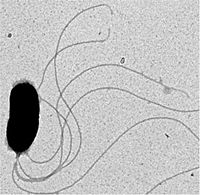Vibrio fischeri: Difference between revisions
imported>Yeong M Shin No edit summary |
imported>Yeong M Shin |
||
| Line 19: | Line 19: | ||
==Description and significance== | ==Description and significance== | ||
Vibrio fischeri is a | |||
Vibrio fischeri is a gram-negative bioluminescent bacterium that is a symbiont to various species of fish and squid. The bacterium is motile with polar flagella and has a curved rod shaped morphology. V. fischeri is a member of the Vibrionacea family of marine γ-proteobacteria which includes several dozen species having symbiotic and pathogenic relationships with animals(Ruby complete genome). The bioluminescent bacteria bio-chemically produces light in a reaction where a substrate molecule, luciferin is oxidized by an enzyme, luciferase. This process emits light energy rather than heat energy (Herring, Biolum). The proteins necessary for the production of bioluminescence are encoded in a set of genes called the lux operon. The expression of the lux operon and other genes depend upon the presence of a signal molecule known as N-acyl homoserine lactone (AHL). The accumulation of the AHL is a function of population density and hence, bioluminescence can only occur after the bacterium reaches a critical population threshold. The process by which gene expression is dependant upon the level of bacterial population in the environment is called quorum sensing (NCBI). Intercellular communication via signal molecules has been shown to regulate genes whose products are needed for establishment of virulence, symbiosis, biofilm formation, plasmid transfer and morphogenesis in a variety of microorganisms (Wiley, textbook). Similar to multicelluar organisms, quorum sensing functions as means for single celled bacteria to communication amongst themselves and act collectively. Prior to its discovery in V. fischeri, quorum sensing and other mechanisms for bacterial cell communication was unknown. | |||
==Genome structure== | ==Genome structure== | ||
Revision as of 18:59, 22 April 2009
For the course duration, the article is closed to outside editing. Of course you can always leave comments on the discussion page. The anticipated date of course completion is May 21, 2009. One month after that date at the latest, this notice shall be removed. Besides, many other Citizendium articles welcome your collaboration! |
| Vibrio fischeri | ||||||||||||||
|---|---|---|---|---|---|---|---|---|---|---|---|---|---|---|
 | ||||||||||||||
| Scientific classification | ||||||||||||||
| ||||||||||||||
| Binomial name | ||||||||||||||
| Vibrio fischeri |
Description and significance
Vibrio fischeri is a gram-negative bioluminescent bacterium that is a symbiont to various species of fish and squid. The bacterium is motile with polar flagella and has a curved rod shaped morphology. V. fischeri is a member of the Vibrionacea family of marine γ-proteobacteria which includes several dozen species having symbiotic and pathogenic relationships with animals(Ruby complete genome). The bioluminescent bacteria bio-chemically produces light in a reaction where a substrate molecule, luciferin is oxidized by an enzyme, luciferase. This process emits light energy rather than heat energy (Herring, Biolum). The proteins necessary for the production of bioluminescence are encoded in a set of genes called the lux operon. The expression of the lux operon and other genes depend upon the presence of a signal molecule known as N-acyl homoserine lactone (AHL). The accumulation of the AHL is a function of population density and hence, bioluminescence can only occur after the bacterium reaches a critical population threshold. The process by which gene expression is dependant upon the level of bacterial population in the environment is called quorum sensing (NCBI). Intercellular communication via signal molecules has been shown to regulate genes whose products are needed for establishment of virulence, symbiosis, biofilm formation, plasmid transfer and morphogenesis in a variety of microorganisms (Wiley, textbook). Similar to multicelluar organisms, quorum sensing functions as means for single celled bacteria to communication amongst themselves and act collectively. Prior to its discovery in V. fischeri, quorum sensing and other mechanisms for bacterial cell communication was unknown.
Genome structure
Cell structure and metabolism
Ecology
Vibrio fischeri can be found in the upper 1000m of the ocean, living freely, or amongst the mixed biota in the guts of marine animals but is more commonly found as symbionts
Pathology
Vibrio fischeri is non-pathogenic to humans but three other members of the Vibrios family are. These are; V. cholerae, V.parahaemolytus, V. vulnificus.